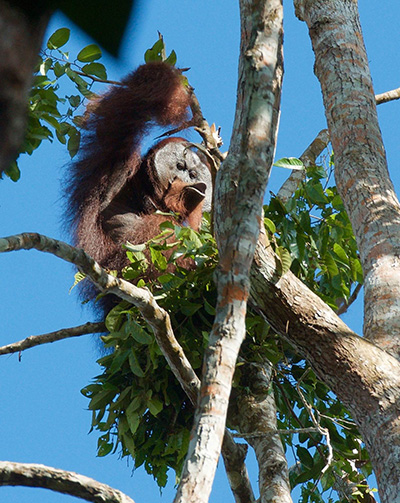A population trend analysis of Bornean orangutans reveals that, despite decades of conservation work, the species is declining rapidly - at a rate of 25 per cent over the past 10 years.
University of Queensland School of Biological Sciences researcher Dr Truly Santika, an Indonesian statistician and researcher at the ARC Centre of Centre for Environmental Decisions (CEED), led the study on the critically endangered Bornean orangutans.
Analyses show declines are particularly pronounced in West and Central Kalimantan, but even in relatively well protected areas, such as the Malaysian State of Sabah, the rate of decline is still 21.3 per cent.
Every year US$30-40 million is invested by governmental and non-governmental organisations to halt the decline of wild populations. The study shows that these funds are not effectively spent.
Dr Santika said, for many threatened species, the rate and drivers of population decline were difficult to accurately assess.
“Our study used advanced modelling techniques that allowed the combination of different survey methods, including helicopter surveys, traditional ground surveys, and interviews with local communities,” Dr Santika said.
CEED Director Professor Kerrie Wilson said the new approach facilitated the break-through and, for the first time, enabled researchers to determine population trends of the species over time.
She described the study, conducted by a group of some 50 Indonesian, Malaysian, and international researchers, as “a wake-up call” for the orangutan conservation community and the Indonesian and Malaysian governments who had committed to saving the species.
One of the study’s initiators, UQ Honorary Professor Erik Meijaard said that the study’s worrying outcomes suggested the need to fundamentally rethink orangutan conservation strategies.
“The biggest threats of habitat loss and killing are not effectively addressed, despite government commitments through national action plans,” he said.
“The focus of orangutan conservation is on rescues and rehabilitation, but that only addresses the symptoms and not the underlying problem.”
According to Dr Marc Ancrenaz, a Sabah-based orangutan scientist and contributor to the study, there is hope for orangutans, despite the negative trends that the study demonstrates.
“As we learn more about orangutans we come to understand that the species is ecologically much more versatile than previously thought,” he said.
“Orangutans can survive in multifunctional landscapes, which includes plantations and agricultural lands. But they are very slow breeders and much more needs to be done to reduce killing rates.”
Previous studies have indicated up to 2500 orangutans are killed annually on Borneo in conflict situations or by hunters looking for food, explaining a considerable part of the orangutan’s decline.
“Inappropriate land use planning is another major factor,” Professor Meijaard said.
“For example, 10,000 orangutans presently occur in areas that have been allocated by national and local governments to oil palm development.
“If these areas are converted to plantations without changes in current practices, most of these animals will be destroyed and the steep population decline is likely to continue.
“Viable populations of large roaming animals such as the orangutan require a network of protected forests that are properly managed, and sustainable practices outside of these protected areas.”
The new study is published in Scientific Reports (DOI:10.1038/s41598-017-04435-9).
Media: Dr Truly Santika, trulysantika@gmail.com; Professor Kerrie Wilson k.wilson2@uq.edu.au,
or +61 7 3365 2829; Honorary Professor Erik Meijaard, emeijaard@gmail.com, or @emeijaard; and Dr Marc Ancrenaz, marc.ancrenaz@yahoo.com, +60 13 875 6009.
.jpg)
